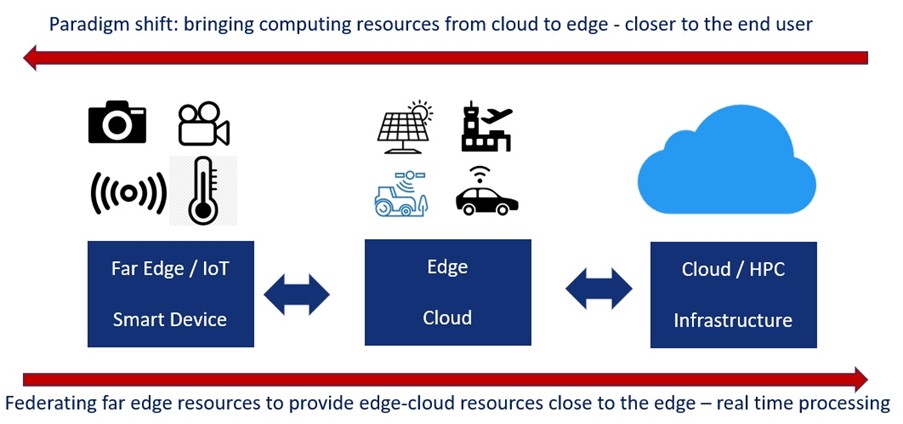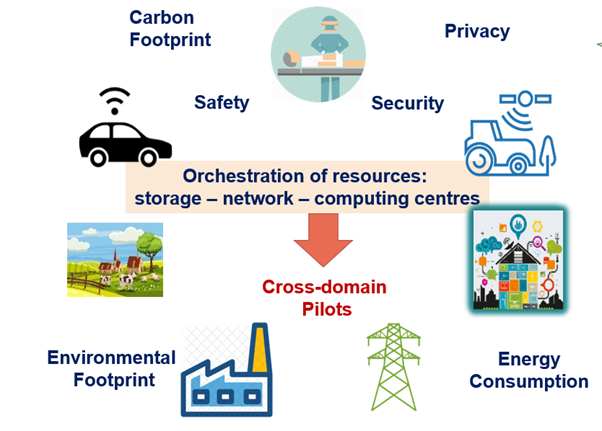IoT transforming traditional industries
The Internet of Things (IoT) enables us to merge the physical and the virtual worlds. It offers innovative solutions and allows us to create smart environments. Internet of Things technologies are at the forefront of the world economy’s digital transformation, alongside the application of distributed and artificial intelligence (AI). Data collected from IoT sensors can be monitored and fed back to a central system to trigger an action, gain insights or respond to another connected object, hundreds of kilometres away.
European IoT and Edge Computing
The rollout of IoT technologies will optimise the way we live our lives. The number of installed IoT connected devices is projected to increase from some 40 billion in 2023 to 49 billion by 2026, growing at a compound annual growth rate of 7% (International Data Corporation). It is also noteworthy that three quarters of European organisations use cloud, while about the same share plans to invest in IoT.
This is leading to an exponential growth of data that is processed at the edge of the network.
This means we can reduce the communication and storage costs, and the energy consumption of data processing.

We can also apply machine learning and AI to safely identify data patterns that impact physical processes or businesses. A set of supporting policy actions have been adopted by the European Commission to accelerate the take-up of the next generation IoT and edge computing and unleash their full potential in Europe for the benefit of EU citizens and businesses.
Together with edge computing, the future IoT will revolutionise the way production and processes are organised and monitored across strategic value chains, bringing the green and digital transitions to European industry.
Web 4.0 and Industrial Virtual Worlds
Driven by the growth of IoT objects and connected systems everywhere, the complexity of data handling at the edge is characterised by data inflation, diversity of data types, and task concurrency.
The evolution towards Web 4.0 and new virtual world emphasises the role of emerging network functions. It is a transition from the Internet of Things to the internet of digital twins, from cloud and central computing to spatial computing. It benefits from advances in user interface technologies like extended reality (XR), and spurs automation and robotics towards the vision of an industrial metaverse.
Among the findings of a recent consultation meeting it was stated that the industrial metaverse is more mature than the consumer-driven metaverse. Stakeholders expressed their views on the importance of distributed intelligence and collaborative industrial systems at the IoT-Edge Continuum as part of broader Cloud-Edge Continuum challenges. As this is an emerging field, further work needs to be done to explore the opportunities and the challenges for European stakeholders.
IoT-related research, development and innovation programmes
Through Horizon Europe calls on "World Leading Data and Computing Technologies", the Commission is financing IoT projects and other activities under Cluster 4 "Digital, Industry and Space" Destination 3:From Cloud to Edge to IoT
In particular, through the calls under the 2021-2022 work programme of Horizon Europe, the EU has invested only around €100 million in this cluster. with research and innovation projects of meta operating systems and programming tools for decentralised intelligence and swarms.
These projects are based on keeping most data processing at the edge and even at device level, rather than in the cloud. They will be implemented over the period 2022-2025. These investments into emerging technologies build on the successes of related Horizon 2020 projects, amounting to around €150 million, some of which ran until 2023. These predecessor projects focused on platform building and large-scale piloting, but they are also contributing to Europe’s green and digital transitions in general. Furthermore, the EU also supports transversal aspects such as ecosystem building, cybersecurity, platform interoperability, technology integration and standardisation.
The calls under the 2023-2024 work programme focus on research and innovation in the cognitive computing continuum as well as on piloting emerging smart IoT platforms and decentralised intelligence. These projects will demonstrate the use of IoT and edge technologies across multiple sectors boosting industrial collaboration through open platforms and standards, and thus achieving European leadership across the entire edge ecosystem.
Spurring a vibrant ecosystem including collaboration with the National Science Foundation
Edge computing is the logical evolution of the dominant cloud computing model, avoiding the transfer of mission-critical data to the cloud by increasing the computing capacity at the edge of the network. Spanning the computing continuum from edge to cloud, the High Performance, Edge And Cloud computing (HiPEAC) community, which is supported by the European Commission, constitutes a dynamic network of around 2,000 computing systems researchers, industry representatives and students to track recent trends and challenges in the computing domain.
On top of this, the European Commission will support collaboration with the National Science Foundation of the United States, with a focus on fundamental research on new concepts for distributed computing and swarm intelligence.
Further details concerning on-going research and innovation projects, and events and opportunities for small and medium-sized enterprises can be found on the European Cloud-Edge-IoT portal. This initiative aims to establish a pathway for the understanding and development of the Cloud, Edge and IoT (CEI) Continuum by promoting cooperation between a wide range of research projects, developers and suppliers, business users and potential adopters of this new technological paradigm.
Further efforts of the digitalisation of European industry are directed through the Connecting Europe Facility and Digital Europe Programmes. For example, the rolling out of common European data spaces in priority sectors like agriculture, energy and mobility.
IoT by sector
The European Commission’s IoT policy spans over numerous vertical sectors, promoting the use of new technologies to boost the digital and green transition of our economy and society.

From the application perspective, the IoT and digital technologies are key enablers for the digital transformation in various sectors. To achieve this digitalisation, the Directorate-General for Communications Networks, Content & Technology (DG CONNECT) works in collaboration with the respective policy DGs to support digital projects in Horizon Europe’s Cluster 5 “Climate, Energy and Mobility” and Cluster 6 “Food, Bioeconomy, natural resources, Agriculture and environment”.
The Directorate-General for Mobility & Transport (DG MOVE) and DG CONNECT are developing synergies between the European Data Strategy and the Sustainable and Smart Mobility Strategy, with a particular focus on the deployment of a common European mobility data space. Both DGs have joined forces with the Directorate-General for Research & Innovation (DG RTD) and the Directorate-General for Internal Market, Industry, Entrepreneurship & SMEs (DG GROW) to develop the topic of connected and automated mobility through a series of complementary policies and through research and development actions.
The Directorate-General for Energy (DG ENER) and DG CONNECT are preparing actions following the Digitalisation of Energy Action Plan, in order to accelerate the digital and sustainable transformation of the EU’s energy system. This work is in line with the Commissions’ European Green Deal, REPowerEU and the Digital Decade policy programme for 2030. It also touches upon enhancing the exchange and data use in the energy sector, with the goal of establishing a common European energy data space.
Lastly, the Directorate-General for Agriculture & Rural Development (DG AGRI) collaborates with the DG CONNECT developing a common European agricultural data space in order to provide for digital transformation of Europe’s farming industry. Current actions are co-funded through Horizon Europe. The deployment of the respective data spaces is to be supported under the Digital Europe Programme in 2024, building on the activities of EU Member States.
Through excellent, effective, and close cooperation between the Commission’s various DGs, the EU is leading by example in areas such as legislation, standardisation and interoperability, cybersecurity, sustainable ICT as well as in supporting research, innovation and deployment. It works with relevant stakeholders from both the public and private sectors and civil society in these areas.
Latest news
Related Content
Big Picture
The EU is accelerating the development and uptake of advanced technologies so citizens and businesses can enjoy the full potential of the digital world.
Dig deeper
The European Union’s Digital Decade policy programme sets our goals for the digital transformation, with 10,000 climate-neutral edge nodes as one target. This means cloud, edge and the Internet of Things have a big role to play.
The future Internet of Things and Edge Computing can revolutionise the way production and processes are organised and monitored across strategic value chains.
A study carried out on Internet of Things (IoT) clusters in Europe provides a deeper understanding of dynamics, drivers and success factors in this area.
The Commission is working to ensure more robust and resilient security frameworks for IoT devices and the networks of which they are a part.
The digitalisation of the European agricultural sector has the potential to revolutionise the industry, promoting efficiency, sustainability, and competitiveness.
See Also
The mission of the Next Generation Internet initiative is to reimagine and re-engineer the Internet of tomorrow, reflecting fundamental human values.
The EU wants to be a leader in blockchain technology, becoming an innovator in blockchain and a home to significant platforms, applications and companies.
Large-Scale Pilot projects - Data Strategy
Industrial platforms and large-scale pilots
Digital industrial platforms are key to placing Europe ahead in the digital transformation, linking...
Large-scale pilots in the digitisation of agriculture
The Commission has set up large-scale pilots to drive the digitisation of agriculture in Europe.
A European strategy for data
The strategy for data focuses on putting people first in developing technology, and defending and...
